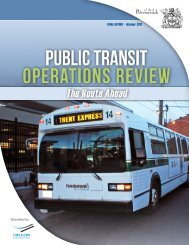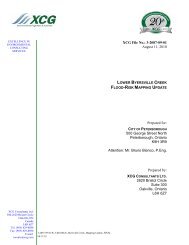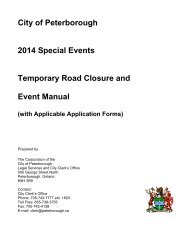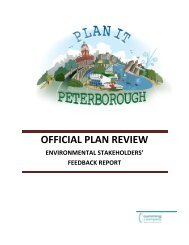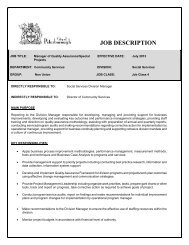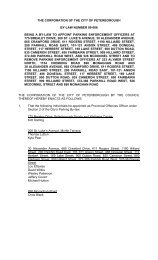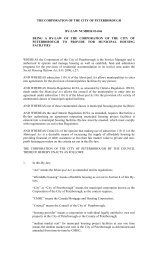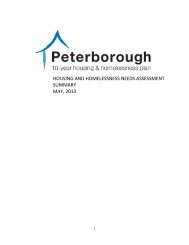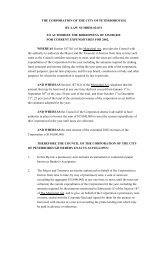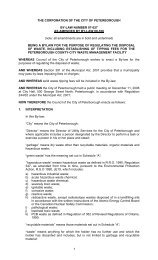Thompson Creek Flood Study Report - City of Peterborough
Thompson Creek Flood Study Report - City of Peterborough
Thompson Creek Flood Study Report - City of Peterborough
You also want an ePaper? Increase the reach of your titles
YUMPU automatically turns print PDFs into web optimized ePapers that Google loves.
<strong>Thompson</strong> <strong>Creek</strong> Detailed <strong>Flood</strong> Reduction <strong>Study</strong><br />
<strong>City</strong> <strong>of</strong> <strong>Peterborough</strong><br />
Future Land Use<br />
Once the existing conditions model had been verified, the <strong>Thompson</strong> <strong>Creek</strong> watershed<br />
was further subdivided as shown in Figure 4.4.2, to allow for an accurate representation<br />
<strong>of</strong> future conditions. The model computes flows at the same locations in the creek but<br />
uses additional detail to fully represent the changed land use conditions. Table 4.4.2<br />
shows the parameters used in this version <strong>of</strong> the model. It should be noted that based<br />
upon the results <strong>of</strong> the “<strong>Thompson</strong> <strong>Creek</strong> Central Stormwater Management Facility<br />
Class EA, Environmental <strong>Study</strong> <strong>Report</strong>,” it was assumed that the northern boundary <strong>of</strong><br />
<strong>Thompson</strong> <strong>Creek</strong> would remain as in the existing conditions model. This is because<br />
that report recommended diversion <strong>of</strong> all flows from the proposed development north <strong>of</strong><br />
<strong>Thompson</strong> <strong>Creek</strong> to a central stormwater management facility adjacent to the Otonabee<br />
River. Since the area is currently occupied by a former quarry, its elevation is below<br />
the creek and currently no storm run<strong>of</strong>f from the area enters <strong>Thompson</strong> <strong>Creek</strong>. Hence<br />
the proposed stormwater management approach will maintain this situation.<br />
Documentation <strong>of</strong> the future conditions model is included in Appendix H.<br />
Table 4.4.1<br />
Visual OTTHYMO Model Parameters for Existing Conditions<br />
Parameter Sub-Catchment<br />
10<br />
Sub-Catchment<br />
11<br />
Sub-Catchment<br />
12<br />
Sub-Catchment<br />
13<br />
OTTHYMO NASHYD STANDHYD STANDHYD STANDHYD<br />
Command<br />
Drainage Area 15.8 18.5 11.5 18.1<br />
(ha)<br />
CN 54 69 69 69<br />
IA (mm) 6 4 4 4<br />
N 3<br />
TP (hr) 0.374<br />
XIMP 0.20 0.20 0.17<br />
TIMP 0.26 0.26 0.22<br />
SLPP (%) 2 2 2<br />
LGP (m) 40 40 40<br />
MNP 0.03 0.03 0.03<br />
DPSI (mm) 0.5 0.5 0.5<br />
SLPI (%) 1 1 1<br />
LGI (m) 351.2 276.9 347.4<br />
MNI 0.013 0.013 0.013<br />
Abbreviations: CN – SCS Curve Number, IA – Initial Abstraction, N – NASHYD No. <strong>of</strong> linear<br />
reservoirs, TP – Time to Peak, XIMP – Directly Connected Imperviousness, TIMP – Total<br />
Imperviousness, SLPP – Slope <strong>of</strong> Pervious Area, LGP – Length <strong>of</strong> Pervious Area, MNP – Manning’s<br />
roughness <strong>of</strong> Pervious Area, DPSI – Depression Storage <strong>of</strong> Impervious Area, SLPI – Slope <strong>of</strong><br />
Impervious Area, LGI – Length <strong>of</strong> Impervious Area, MNI – Manning’s roughness <strong>of</strong> Impervious<br />
Area.<br />
14-06605-01-W01 <strong>City</strong> <strong>of</strong> <strong>Peterborough</strong> 46




